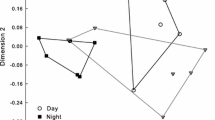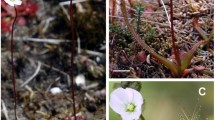Abstract
Flowering plants attract pollinators via various stimuli such as odor, color, and shape. Factors determining the foraging behavior of pollinators remain a major theme in ecological and evolutionary research, although the floral traits and cognitive ability of pollinators have been investigated for centuries. Here we show that the autofluorescence emitted from pollen and anthers under UV irradiation may act as another attractant for flower-visiting insects. We have identified fluorescent compounds from pollen and anthers of five plant species as hydroxycinnamoyl derivatives. The fluorescent compounds are also shown to quench UV energy and exhibit antioxidant activity, indicating a function as protectants of pollen genes from UV-induced damage. A two-choice assay using honeybees in the field demonstrated that they perceived the blue fluorescence emitted from the fluorescent compounds and were attracted to it. This result suggested that the fluorescence from pollen and anthers serves as a visual cue to attract pollinators under sunlight.





Similar content being viewed by others
References
Birkofer L, Kaiser C, Nouvertné W, Thomas U (1961) Natürlich vorkommende Zuckerester von Phenolcarbonsäuren. Z Naturforsch B 16:249–251
Birkofer L, Kaiser C, Thoman U (1968) Acteosid und Neoacteosid: Zuckerester aus Syringa vulgaris (L.). Z Naturforsch B 23:1051–1058
Bokern M, Wray V, Strack D (1987) Hydroxycinnamic acid esters of glucuronosylglucose from cell suspension cultures of Chenopodium rubrum. Phytochemistry 26:3229–3231
Cheminat A, Zawatzky R, Becker H, Brouillard R (1988) Caffeoyl conjugates from Echinacea species: structures and biological activity. Phytochemisitry 27:2787–2794
Dafni A, Lehrer M, Kevan PG (1997) Spatial flower parameters and insect spatial vision. Biol Rev 72:239–282
Dötterl S, Vereecken N (2010) The chemical ecology and evolution of bee-flower interactions: a review and perspectives. Can J Zool 88:668–697
Dyer AG, Neumeyer C (2005) Simultaneous and successive colour discrimination in the honeybee (Apis mellifera). J Comp Physiol A 191:547–557
Dyer AG, Boyd-Gerny S, Shrestha M, Lunau K, Garcia JE, Koethe S, Wong BBM (2016) Innate colour preferences of the Australian native stingless bee Tetragonula carbonaria Sm. J Comp Physiol A 202:603–613
Fischer HOL, Dangschat G (1932) Konstitution der Chlorogensäure (3. Mitteil. über Chinasäure und Derivate). Ber Dtsch Chem Ges 65:1037–1040
Fukui H, Hirai N, Mori S, Goto K, Toyoda J, Tsukioka J (2017) Floral fluorescence database. The Garden of Medicinal Plans, Kyoto Pharmaceutical University. http://labo.kyoto-phu.ac.jp/mpgkpu/ffd.html. Accessed 7 Sep 2017
Gandía-Herrero F, García-Carmona F, Escribano J (2005a) Floral fluorescence effect. Nature 437:334
Gandía-Herrero F, Escribano J, García-Carmona F (2005b) Betaxanthins as pigments responsible for visible fluorescence in flowers. Planta 222:586–593
García-Plazaola JI, Fernández-Marín B, Duke SO, Hernández A, López-Arbeloa F, Becerrila JM (2015) Autofluorescence: biological functions and technical applications. Plant Sci 236:136–145
Giurfa M, Nunez J, Chittka L, Menzel R (1995) Colour preferences of flower-naive honeybees. J Comp Physiol A 177:247–259
Giurfa M, Vorobyev M, Kevan P, Menzel R (1996) Detection of coloured stimuli by honeybees: minimum visual angles and receptor specific contrasts. J Comp Physiol A 178:699–709
Gumbert A (2000) Color choices by bumble bees (Bumbus terrestris): innate preferences and generalization after learning. Behav Ecol Sociobiol 48:36–43
Hamerski L, Bomm MD, Silva DHS, Young MCM, Furlan M, Eberlin MN, Castro-Gamboa I, Cavalheiro AJ, Bolzani VS (2005) Phenylpropanoid glucosides from leaves of Coussarea hydrangeifolia (Rubiaceae). Phytochemistry 66:1927–1932
Hempel de Ibarra N, Vorobyev M, Menzel R (2014) Mechanisms, functions and ecology of colour vision in the honeybee. J Comp Physiol A 200:411–433
Hixson JL, Hayasaka Y, Curtin CD, Sefton MA, Taylor DK (2016) Hydroxycinnamoyl glucose and tartrate esters and their role in the formation of ethylphenols in wine. J Agric Food Chem 64:9401–9411
Hoque E, Remus G (1999) Natural UV-screening mechanisms of Norway spruce (Picea abies [L.] Karst.) needles. Photochem Photobiol 69:177–192
Hung CY, Tsai YC, Li KY (2012) Phenolic antioxidants isolated from the flowers of Osmanthus fragrans. Molecules 17:10724–10737
Iriel A, Lagorio MG (2010) Is the flower fluorescence relevant in biocommunication? Naturwissenschaften 97:915–924
Kevan PG (1976) Fluorescent nectar. Science 194:341–342
Kurup R, Johnson AJ, Sankar S, Hussain AA, Kumar CS, Sabulal B (2013) Fluorescent prey traps in carnivorous plants. Plant Biol 15:611–615
Kweon MH, Hwang HJ, Sung HC (2001) Identification and antioxidant activity of novel chlorogenic acid derivatives from bamboo (Phyllostachys edulis). J Agric Food Chem 49:4646–4655
Lagorio MG, Cordon GB, Iriel A (2015) Reviewing the relevance of fluorescence in biological systems. Photochem Photobiol Sci 14:1538–1559
Lunau K (2000) The ecology and evolution of visual pollen signals. Plant Syst Evol 222:89–111
Mayer C, Adler L, Armbruster WS, Dafni A, Eardley C, Huang S, Kevan PG, Ollerton J, Packer L, Ssymank A, Stout JC, Potts SG (2011) Pollination ecology in the 21st century: key questions for future research. J Pollination Ecol 3:8–23
Nishimura H, Sasaki H, Inagaki N, Chin M, Mitsuhashi H (1991) Nine phenethyl alcohol glycosides from Stachys sieboldii. Phytochemistry 30:965–969
Park KH, Park M, Choi SE, Jeong MS, Kwon JH, Oh MH, Choi HK, Seo SJ, Lee MW (2009) The anti-oxidative and anti-inflammatory effects of caffeoyl derivatives from the roots of Aconitum koreanum R. RAYMOND. Biol Pharm Bull 32:2029–2033
Parker CA, Rees WT (1962) Fluorescence spectrometry. A review. Analyst 87:83–111
Peitsch D, Fietz A, Hertel H, de Souza J, Ventura DF, Menzel R (1992) The spectral input systems of hymenopteran insects and their receptor-based colour vision. J Comp Physiol A 170:23–40
Potts SG, Imperatriz-Fonseca V, Ngo HT, Aizen MA, Biesmeijer JC, Breeze TD, Dicks LV, Garibaldi LA, Hill R, Settele J, Vanbergen AJ (2016) Safeguarding pollinators and their values to human well-being. Nature 540:220–229
Quilichini TD, Grienenberger E, Douglas CJ (2015) The biosynthesis, composition and assembly of the outer pollen wall: a tough case to crack. Phytochemistry 113:170–182
Roschina VV (2012) Vital autofluorescence: application to the study of plant living cells. Int J Spectrosc 124672
Rozema J, Broekmana RA, Blokkerb P, Meijkampa BB, de Bakkera N, van de Staaij J, van Beem A, Ariese F, Kars SM (2001) UV-B absorbance and UV-B absorbing compounds (para-coumaric acid) in pollen and sporopollenin: the perspective to track historic UV-B levels. J Photochem Photobiol B Biol 62:108–117
Sakuma M, Fukami H (1985) The linear track olfactometer: an assay device for taxes of the German cockroach, Blattella germanica (L.) (Dictyoptera: Blattellidae) towards their aggregation pheromone. Appl Entomol Zool 20:387–402
Scarpati ML, Guiso M (1964) Structure of the three dicaffeoyl-quinic acids of coffee (isochlorogenic acid). Tetrahedron Lett 5:2851–2853
Seeley TD (1995) The wisdom of the hive: the social physiology of honey bee colonies. Harvard University Press, Cambridge
Thorp RW, Briggs DL, Estes JR, Erickson EH (1975) Nectar fluorescence under ultraviolet irradiation. Science 189:476–478
Vanbergen AJ, The Insect Pollination Initiative (2013) Threats to an ecosystem service: pressures on pollinators. Front Ecol Environ 11:251–259
von Frisch K (1967) The dance language and orientation of bees. Harvard University Press, Cambridge
Wald B, Wray V, Galensa R, Herrmann K (1989) Malonated flavonol glycosides and 3,5-dicaffeoylquinic acid from pears. Phytochemistry 28:663–664
Williamson CG, Zepp RG, Lucas RM, Madronich S, Austin AT, Ballaré CL, Norval M, Sulzberger B, Bais AF, McKenzie RL, Robinson SA, Häder DP, Paul ND, Bornman JF (2014) Solar ultraviolet radiation in a changing climate. Nat Clim Chang 4:434–441
Acknowledgements
We thank Mr. M. Kaneko (Nagano Vegetable and Ornamental Crops Experiment Station) for providing flowers of P. persica. We wish to acknowledge Assistant Professor M. Murai and Mr. K. Nishino, and Assistant Professor T. Suzuki (Graduate School of Agriculture, Kyoto University) for the mass spectral measurements and the UV/Vis measurements, respectively. For the two-photon excitation microscopy, we thank Ms. K. Takakura at the Fluorescent Live Imaging Core Facility of the Medical Research Support Center, Graduate School of Medicine, Kyoto University, which was supported by Platform for Drug Discovery, Informatics, and Structural Life Science from the Ministry of Education, Culture, Sports, Science and Technology, Japan. We also wish to thank Ms. K. Okamoto-Furuta and Mr. H. Kohda (Center for Anatomical, Pathological and Forensic Medical Researches, Graduate School of Medicine, Kyoto University) for their technical assistance with electron microscopy. Advice and comments given by Associate Professor T. Miyake (Graduate School of Agriculture, Kyoto University) were a great help in the statistical analysis. We are deeply grateful to Professor K. Arikawa (School of Advanced Sciences, Graduate University for Advanced Studies) and Professor Emeritus M. Sasaki (Tamagawa University) for valuable discussion on the behavioral experiments with honeybees. We would like to express our sincere gratitude to Ms. Y. Fukui for warm encouragement.
Author information
Authors and Affiliations
Corresponding author
Additional information
Hiroshi Fukui and Katsumi Goto died before publication of this work was completed.
Electronic supplementary material
ESM 1
(DOCX 4439 kb)
Rights and permissions
About this article
Cite this article
Mori, S., Fukui, H., Oishi, M. et al. Biocommunication between Plants and Pollinating Insects through Fluorescence of Pollen and Anthers. J Chem Ecol 44, 591–600 (2018). https://doi.org/10.1007/s10886-018-0958-9
Received:
Revised:
Accepted:
Published:
Issue Date:
DOI: https://doi.org/10.1007/s10886-018-0958-9




